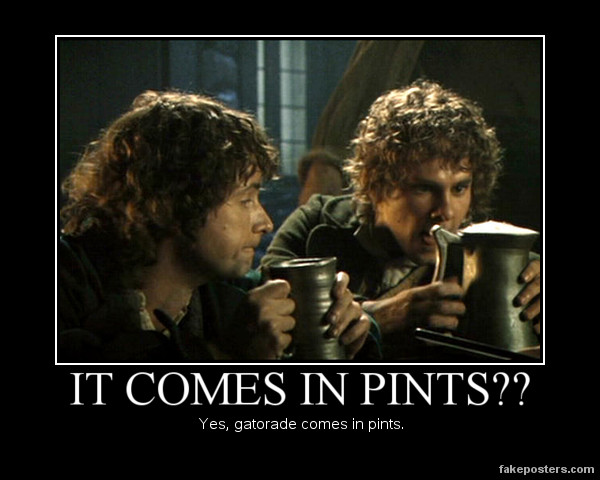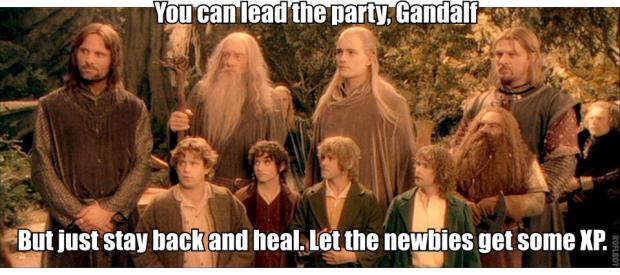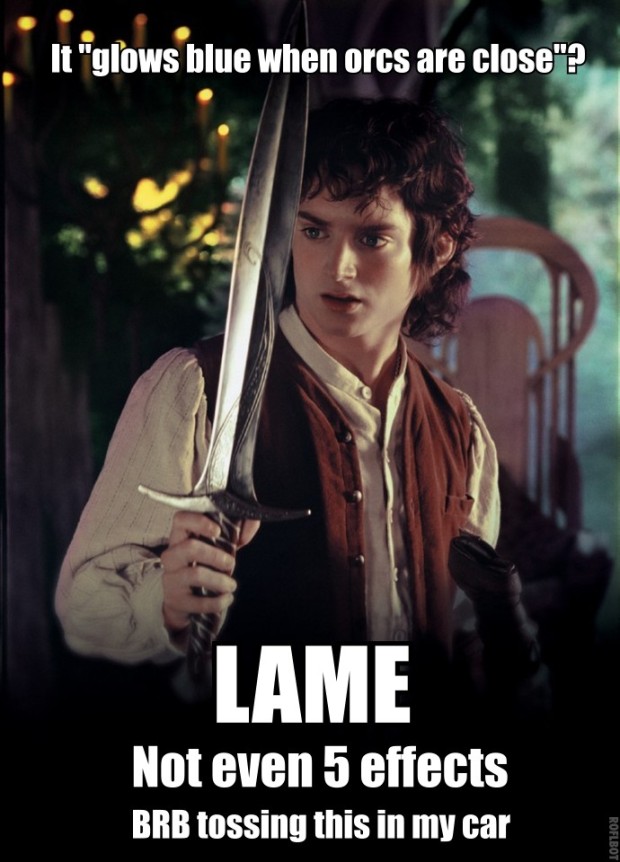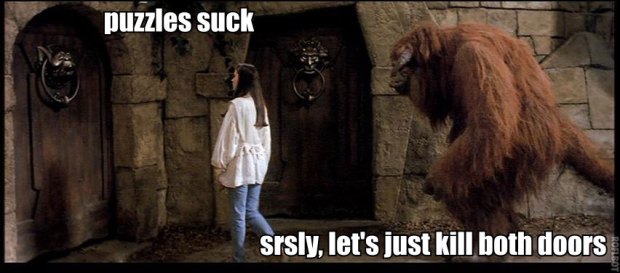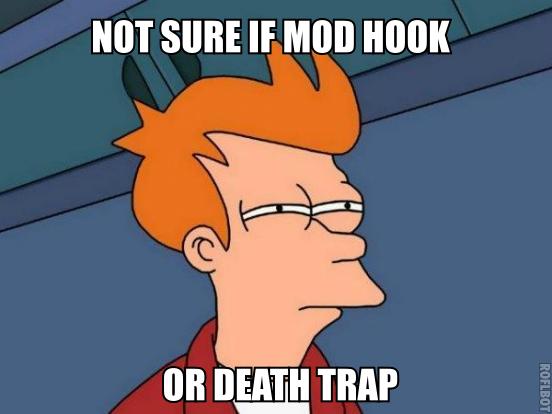Archive for category Uncategorized
LARP Memes
Posted by fresh heir in Uncategorized on May 8, 2012
Here are some dumb images I made:
I love coming up with names for “moves” you use at LARPs. For example, “The Barnacle” is a move where you stand next to somebody that’s about to go on adventure and hope they bring you along. The above image is the “Majestic Seagull”, which is when you gracefully swoop in and search somebody else’s kill.
This one will make sense to anybody that’s ever been in a tavern at a no-alcohol LARP.
Few things in this world fill me with more joy than watching somebody pretend powdered lemonade is a fine ass Elven wine.
One of the best thing about being high level is getting to “babysit” a bunch of newbies on an adventure and just dicking around like you don’t give a fuck. If the Fellowship were a LARP party, Gandalf would have done a lot more eyerolling and patting people on the head.
(A bit of explanation may be necessary for the above image: In NERO, you can only use five magic items at once. And an item can have a maximum of five magical effects. So if you’re loaded up on items, and you find one that only has one or two effects you are expected to react with disgust. Under no circumstances should you give the item to the group of newbies with zero items standing 15 feet away)
Here’s the trick to being good at LARP riddles” The answer to the riddle is probably one of the following: time, shadow, death, flame, wind, a coin, the letter e, nothing. If you memorize this list, and the half dozen riddles in The Hobbit, nobody at a LARP will ever stump you.
It’s expected that the farmer who sends you on a quest is probably more powerful and evil than any creature you will face on that quest. I’ll let you guys decide whether the above farmer is actually a vampire, superlich, or is just an ungrateful prick.
Hey dude, do you really need six people to find your missing gimlet? Or is six the maximum number of people you can kill with a single swing?
LARP and Journalism
Posted by fresh heir in Uncategorized on May 4, 2012
Hi Nerology! Long time no see. I’ve been working on a ton of stuff for NERO National, as well as a few cool side projects that I’ll share more about if people are interested. One involves a 24/7 adventure system that I’m working on. Another involves putting together a consulting group to support LARPwrights and people making films about live games.
Today’s post, however, is thanks to Zoe, who writes the excellent blog CollabNarration: A Collective Narrative. Between CollabNarration, LARP Ohio (with Bill Tobin) and Rob Ciccolini’s new blog Gamesthetic, a nice little LARPwright blogging community is popping up, no? (As a quick aside, what I love about all of those blogs is that they serve the LARP community as a whole. There’s some really juicy stuff on those blogs no matter what game you play or run.)
Yesterday, Zoe posted her initial reactions to Lizzie Stark’s new book, Leaving Mundania, and invited we blaggerz to continue the discussion. So here’s my response to Zoe’s points…
First, I don’t think our hobby is terribly opaque. After a year and a half of LARPing, you’ll gotten a pretty big taste of what it is. Your third year of LARPing isn’t going to be packed with new surprises. Maybe a few. But at that point, you already have concrete expectations for the games you’re playing. While there is a deep rabbit hole of LARP theory and dramaturgy which you could spend years studying, all that stuff is not necessary to appreciate the medium as a player. So I don’t think that you need a long LARPing career behind you before you should feel comfortable writing about it.
If anything, isn’t our hobby better served by having “outsiders” advocate it? I think a voice which says “This is what it looks like through a newcomer’s eyes” highlights the genre’s accessibility, makes it easier to take the plunge and attend your first game. If her target audience is LARP outsiders, that’s the frame through which she should present her observations.
On the taxonomy of games: as to what is a LARP or what is not a LARP… These categorization exercises are (IMHO) the least important/interesting parts of LARP academia. It reminds me of my metal-head friends arguing about whether a particular song is “post-rock” or “post-metal”. It has little bearing on anything except people who think those categories are real.
 Moreover, I have to speak up against the characterization of LARPers are a “stigmatized culture”. I think that’s a tad melodramatic. It’s not like we’re trans-gendered or handicapped or systematically oppressed. We have an unusual hobby, which we do in private. Some people laugh at pictures of it on the net, but so what? People on the net laugh at everything. I certainly don’t feel stigmatized.
Moreover, I have to speak up against the characterization of LARPers are a “stigmatized culture”. I think that’s a tad melodramatic. It’s not like we’re trans-gendered or handicapped or systematically oppressed. We have an unusual hobby, which we do in private. Some people laugh at pictures of it on the net, but so what? People on the net laugh at everything. I certainly don’t feel stigmatized.
There were some kids at the last Madrigal event who drove by the campsite honking their horn. That’s is the most push back I’ve felt in over 5 years. And those were a bunch of stupid teenagers, I didn’t lose any sleep over it. After that, they probably went home, played pokemon, and shouted racial profanities at XBox live.
But more to Zoe’s point – do I think broadening the definition of LARP threatens the integrity of existing games? I don’t think so. There’s already a wide spectrum of subgenres of LARP – we happen to play a “light-touch boffer fantasy weekend” style game, and I don’t see how our integrity would be lessened if “full contact historical reenactment” was in the same tent.
Our hobby needs no protection against diffusion – it’s not a cultural heirloom we have to preserve. All of us – narrativists, simulationists, gamists, social butterflies, full contact jocks, RP hams, reenactors, Jugger players – our hobbies are remarkably similar. We like getting outside, seeing our friends, being in a imaginary place, surrounding ourselves with quirky like minded friends, and cooperating and competing towards some imaginary end. The more styles of LARP I play, the more I’m struck by the similarities across genres. Dagohir players and SCAdians may not identify with the label “LARP”, but there’s no question in my mind that in the big scheme of things, we share a tent.
Anyway, I still have yet to read Lizzie Stark’s book, but I’m ordering it right now. I want to thank Zoe for drawing our attention to it and kicking off a very interesting discussion.
Building a Boost Transform
Posted by fresh heir in Crunch, Uncategorized on June 17, 2011
A Boost Transform is a hook for a single low level character to get involved in modules scaled for a higher level party. Here’s a quick guide to building one for a specific character.
Boost Transforms can be conceptualized in other forms than as an enchantment which turns a character into another creature. This framework can just as easily be used to create Boost Artifacts or Boost Boons (granted by an NPC). Technically, the Boost can be treated like a Curse of Transformation. (9th ed rulebook p90)
The goal of a Boost Transform is to provide about enough power to let a player face the enemy NPCs on fair terms. It shouldn’t make him the toughest character there. But it should give him a unique trick, a way of supporting his allies, or a cool moment.
A Boost Transform can be measured in terms of how many effective levels it adds. Calculate the level difference between the party and the low level player they’re bringing. If a level 8 character is tagging along with a party whose average level is 28, you can build the Boost Transform with a budget of about 15-20 levels.
Add a certain amount of defense based on the Boost Transform’s level. For each level, add a point of body, physical armor, arcane armor, dexterity armor, body points, or a mix.
For fighters, the simplest route is to add a strength bonus. A quick rule of thumb is to add 2 point of strength for every 3 levels. (roughly equivalent to granting 2 profs at 15 build) If the other fighters on the module can drop a monster in 4 swings, then a boosted fighter should be able to kill it in 5 or 6. A level can also be spent on a parry/slay, 1-3 physical weapon attacks (ie “physical strike flamebolt (20)”), or the ability to swing 10s as a critical attack.
For scholars, the basic idea is to make sure that they can throw a lot of spells without expending all their resources for the weekend. One method is to allow spellcasters to treat the adventure as if it’s a full day of spells. After it’s over, their spell pyramid will return to what it was before they began the module. Another method is to add a pool of of 20 healing or elemental damage per level which they can cast in increments of 5 or 10 at a time, similar to the element’s fury cantrip. You can grant a few times-ever spell-like abilities such as Dragon’s Breath or Cure Mortal Wounds, or allow the caster to regain a certain number of spell slots by meditating after each encounter during the adventure.
Templars Boost Transforms combine the building techniques for fighters and scholars.
Boost Transforms for Rogues are built similar to fighters, but substitute assassinate/dodge and waylay, for fighter skills and grant twice as much backstab damage as you would strength.
A Boost Transform’s stats are clustered around a theme. This often reflects a role in combat such as melee, ranged attacks, healing, buffing, debuffing, or ambush. They usually also incorporate a setting flavor such as golems, fae, necromancy, celestial magic, earth magic, tyrran forces, lycanthrope, or one of the elements.
NERO LARP Rulebook (9th edition)
Posted by fresh heir in Uncategorized on June 17, 2011
NERO 9th Edition Formal Magic Rules
Posted by fresh heir in Uncategorized on June 16, 2011
National Plot: The Local Impact Model
Posted by fresh heir in Uncategorized on April 20, 2011
I’ve been doing a lot of thinking about National Plot. I’ve come up something tentatively called the Local Impact Model. It might be a more efficient way of running large-scale plot for a big game like NERO.
There are 40+ chapters of NERO which all exist in the same world. Each chapter has its own plot team. There is also a “national” plot team which theoretically manages the overall setting and some plot lines which take place in multiple chapters at once.
In the past, this has been somewhat inefficient. It requires national staff members to travel all over the country to run plot, and it requires that local chapters be receptive to it. These are both problematic. We’ve tried a number of ways to make it smoother, but running plot in more than one chapter, let alone 40 chapters, is always a logistical nightmare.
For example, I recently found out that there was a drought in the year 609. The plane of water was damaged by something that happened during a national plot line, and it had consequences all over Avalon. But I wasn’t playing at one of the chapters that featured this plot, so I had no idea. I think there’s probably a better way to present a world event!
So let’s step back a bit and take a look at what National Plot should do…
- National plot lines should create shared experiences in all participating chapters. This heightens a sense of common culture. Certain current events should affect everybody in the world, and this will theoretically add to the sense that our world is a real place. A player from Pennsylvania should be able to talk to a player from Ohio and say “Remember the earthquake of 612?” and the other player will say, “Yeah, one of our barons died in that earthquake.” They have unique experiences connected by a common event.
- National plotlines should make the actions of players outside of your chapter directly relevant to you. As is, there is little reason to gossip about things that happen outside of your chapter. People may slay a dragon in Atlanta, but we won’t hear about it in the northeast unless somebody was actually there. I think that a well organized National plotline should make you care about how players in other chapters have solved their problems. If you travel to other chapters running the plotline, you will be able to impact things on a really large scale.
I’ve come up with a model for National Plot which addresses these things. In one sentence, the Local Impact Model of plot involves distributing a standard module which can be run in any NERO chapter and allows players to vote on the plotline’s outcome. I am posting about here to initiate a discussion about it. I’d love to hear your constructive feedback.
More below the break…
“Putting Fear Back Into the Game”
Posted by fresh heir in Behind the Scenes, Fluff, Miscellaneous Tip, Uncategorized on August 13, 2009
Often, you will hear a LARP director say he wants to “Put fear back into the game.” This is a noble motivation, but in practice, it is often used as an excuse for running a deadly encounter, a merciless wave battle, or overstatting some heinous creature. To be clear: emotional experiences like fear are exactly what LARPs are all about, but forcing players to engage in losing encounters generally makes for unfun gameplay.
If you ever find yourself writing an encounter in which the only outcome is the players fleeing, carefully evaluate what potential experiences you are creating. You may think that forcing the players to hide inside protective circles, or flee too the woods entirely, will become an exciting encounter. It will probably only be fun for a few of them. Others will feel frustrated that you gave them a challenge with no chance of success. What you are essentially telling them is that the “winning” strategy is to not participate; when the stakes are high, it’s better to fold than to lose. Their perception may be that you merely “overscaled” the encounter, basically a technical error. Not fear!
Here are a few ways you can create fear in your players without relying on disproportionate mortal danger:
- Isolation – when the players can hang out in a large group, they have access to lots of healing and other resources. There is little threat unless you stray from the pack. Being outnumbered is also scary, which is unlikely to happen when everybody’s clumped up. Pack spikes and objective points are two common methods for discouraging clumping. A pack spike is a powerful monsters which only attacks if players stand in a group larger than six. To avoid the creature, they will have to divide into smaller parties. An objective point is a goal or task that forces groups of players to go off alone. Someone may need an escort through the dangerous woods, or a magic candle may need to stay lit for a period of time. The players find themselves hanging out away from the safety of their friends.
- Foreshadowing – Use colored lights, sound effects, a certain music, or a special effect to set the mood before an event happens. A hidden boom box or speakers can subtly broadcast a monster’s hunting noise (such as the chh-chh-chh noise that a giant insect might make) before an attack. If you turn on red flood lights before a combat encounter, players will eventually be conditioned to expect danger whenever they’re in red lights. Before a werewolf shows up, injured NPCs will run into town, terrified, “It’s coming!” Then, they hear the wolf’s howl…
- Suspense – let the anticipation of an event build up. Especially an event which may threaten the player’s safety. Likewise, time limits have a way of working players into a frenzy as the clock ticks down.
- Atmosphere – foster an environment which is in-game and immersive. The more they think about the rules or how the game works (as opposed to how the game world works), the less connected they are to the experience you’re crafting. Hearing a description of something scary does not induce horror either. All too often, we’re supposed to be scared because we know that a great crashing sound heralds the arrival of Zorkon the Conqueror… and then some dude in sweat pants, glasses, and sneakers lumbers forth. Use costume, makeup, and special effects so that players have to use as little imagination as possible.
- Confederates – (aka Redshirts) send out some cowardly NPCs who the players must protect. By reacting to the situation at hand without being corny or silly, NPCs can set the mood. (“setting an emotional precedent”)
- Don’t overdo it – Too much stress and anxiety can leave the players drained and frustrated, or desensitize them to the effect you’re trying to create. Give them breaks and safe points to get their bearings. To experience danger, you must first feel safe. In some ways, fear comes from this contrast between danger and safety.
The Battle Board: A Game Within a Game
Posted by fresh heir in Adventure Weekends, Uncategorized on July 30, 2009
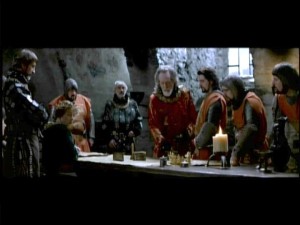 The Battle Board is a LARP device which can be integrated into an adventure weekend. It is a board game within a game. In it, players command armies and engage in tactical mass combat. For important battles, they’ll be able to gate onto the battlefield and lead the offense personally.
The Battle Board is a LARP device which can be integrated into an adventure weekend. It is a board game within a game. In it, players command armies and engage in tactical mass combat. For important battles, they’ll be able to gate onto the battlefield and lead the offense personally.
This mechanic will simulate a large decentralized battle which lasts for the majority of the event. You will need a map of the battlefield which is divided into regions. Generally, the map should cover the town that the players are in and the 20 square miles around it. Design it like a Risk map, with irregularly shaped territories. During the game, tokens will be placed on this map to represent the player’s and NPC’s forces.
Hiring Soldiers – Throughout the weekend, players may acquire the allegiance of soldiers or mercenaries. NPCs playing the captains of each company will approach adventurers in the tavern, looking for leadership. Mercenaries will hire themselves out, whereas companies of soldiers might pledge themselves to the nobility. Make sure that there are enough companies that every player or team has access to at least one. Don’t make it too expensive -each piece will represent a piece on the game board, and it’s a lot of fun if everybody has a piece.
Each company has a value between 1-5, representing its size and skill. As a default, each number represents about 10 people (so a unit with about 30 soldiers has a value of 3).
Certain units may have special objectives or properties, such as local rangers who are sworn to battle all orcs, or local militia who cannot go more than two territories from their hometown.
The Game Board – The game map will be placed in the tavern, or some other accessable, safe location. Tokens on the board represent friendly and hostile companies, many of which will be under the command of one or more players.
For pieces, you can use tabletop gaming miniatures or use pieces from commercial wargames such as Weapons and Warriors. Put candles and soft lighting around the map, and dress up the area to make it feel like a war room. As the players wait anxiously for the scout to return with the results of the last hour’s orders, this should feel more immersive than a board game!
This is just a map, not a magical represntation of the battlefield. It will be updated by a scout once an hour. The scouts have a complex communication system which involves flags, magic flares, and whispering wind spells. They are able to quickly survey the battlefield and send word on how the map should be updated. Once per hour, a player may talk to that scout and give order to any troops he commands. The scout will write down the command and relay it to the troops.
Once an hour, the scout will go off stage and process all the commands. When he’s done, he’ll return to the game and adjust the game board to reflect the results.
To make this seem as realistic as possible, do not let the players see the die rolls, and never reference the gameplay mechanics of this system. Their information about the battle should come from the scouts. It easier to imagine a real battle when you’re hearing a report, as opposed to thinking about numbers or other abstractions.
Battle Mechanics – you can use any mechanic you’d like to determining how far units can move and how to resolve combat. A very simple system is perhaps the best. When two units come into conflict, each one gets to roll a d6 and add its power value. The difference in numbers determines which side suffers damage, and how much.
Players are allowed to give creative orders to to their units, especially if the unit has a special concept or skill. For example, a player commanding a unit of dark elves might order an ambush when attacking at night. A unit of dwarves may have explosives they can use to level enemy walls. A unit of elven archers can attack units one square away if they are on higher ground.
Terrain can provide special conditions too – occupying a town might provide a defensive advantage, or an opportunity for adventurers to gate in and begin pillaging it (see below).
If the enemy makes it to the edge of the town that the players are in, they’ll actually show up on-stage with swords drawn — and attack!
Gate Stones – This battle will be going on in the background as the adventure weekend continues. For the most part, the action is on a map in the tavern. But players can participate more directly, too. By using gate stones, magical items which can be found during the weekend, they can teleport their party to the battlefield and relieve their troops. In these module, the players will fight waves of NPCs representing the opposing army. (for example, an army of 40 soldiers could be represented by 10 NPCs who each respawn 4 times) .
This type of relief might be required if the enemy unit contains an elite combatant such as a monster, high level commander, or other “boss fight” type character. (regular troops just aren’t equipped to fight magic-to-hit creatures!) Other special scenarios might also require assistance from the adventurers. For example, enemy archers stand atop a tower which gives them additional range. The players can gate to the top of the tower and stop the archers, allowing the troops below to move through the region unharmed.
Who’s in Charge Here? In a real war, there’d be only a few commanders who would make decisions for the entire force. But that wouldn’t be any fun for gameplay. In this model, all players are supposed to get a turn.
Historically, in addition to soldiers, medieval warfar utilized a lot of mercenaries. In our game, the nobles each get a unit or two of soldiers, but the mercenaries prefer to report to freelance adventurers or adventurer companies. If they suspect that their orders are actually coming from someone other than their commander, they’ll start to lose morale.
The Atmosphere of War – The region is electrified by the presence of war. Peasants will seek refuge, monsters will be roused from their lairs, and villages will be pillaged. The other encounters going on during the adventure weekend should reinforce the idea that there’s a big battle going on nearby! During these encounters, players might have the opportunity to do things which influence the battle. For example, the enemy army has marched through a local graveyard, sowing the area with necromancy as they went. The dead arise and the players must show up to save the day. In doing so, they earn the respect of the local militia. That party now gains access to a piece on the board representing the forces of that town. Or perhaps there is a swamp populated by hostile wild elves. If the players go there and make peace with them, they will be able to move troops through that space on the board.
The Climax – the most important battle of the weekend should be a climax of some sort, in which all the adventurers get to gate in to help. This is a big wave battle where everybody can help participate in the glorious triumph. But if they haven’t played the battle game well, and haven’t softened up the enemy forces enough yet, they might be overwhelmed! Players can retreat through the gate which took them here, but cannot return through it again.
Ask Joe V
Posted by fresh heir in Uncategorized on July 8, 2009
Over on the NERO Forums, Joe V recently answered some questions about what’s going behind the scenes at NERO. For the NERO players that don’t read the forums, I’ve reposted Joe’s answers below the cut.
Two days later… whew!
Posted by fresh heir in Bragging, Uncategorized on June 24, 2009
I don’t know what came over me in the last few days. Since I set up this blog, I have been an unstoppable writing machine. I wrote something like 11,000 words in a 24 hour period. What the hell is my problem?
I’d been meaning to get a lot of these thoughts on paper for years. After I made my first post here, the seal had been broken. It’s a lot like like staying up all night at a LARP by drinking a gallon of coffee. The next morning you wake up early and flood the world with an unceasing torrent of urine.
A lot of these thoughts emerged from observing how LARPs are run in different parts of the country. I’ve sampled many styles of games – I know that there’s no correct way to run something as big and subjective as a LARP. But few people get a formal introduction to running a game – they sign up to staff, and shortly thereafter, they find themselves plunged into the deep end.
Running a LARP takes more responsibility than running a tabletop. A LARP director is one part Dungeon Master and one part Event Coordinator. If those two jobs weren’t complex enough, they also have to handle public relations, money, and forum moderation. (It’s not an easy job, but it’s very rewarding!)
So to get people up to speed, particularly people who are new at this, I want to expand this series of articles to create a somewhat comprehensive guide about running not just NERO, but live-combat fantasy LARPs in general.
Eventually, my goal is to compile these rants into a single document which I will make available for new staff members. As such, expect these posts to change over time as modify them and get feedback. (Please post feedback!)
What topics do you feel we should cover? When you started staffing, was there anything you needed to know? What sort of stuff should all LARP staff members be aware of?
![]() I will gladly publish articles submitted for for Nerology so long as they are submitted under a Creative Commons License. I will gladly credit you! But because I may need to edit the submission, and may want to eventually sell this book, I reccommend this license. (all you have to do is mention it in your post)
I will gladly publish articles submitted for for Nerology so long as they are submitted under a Creative Commons License. I will gladly credit you! But because I may need to edit the submission, and may want to eventually sell this book, I reccommend this license. (all you have to do is mention it in your post)

